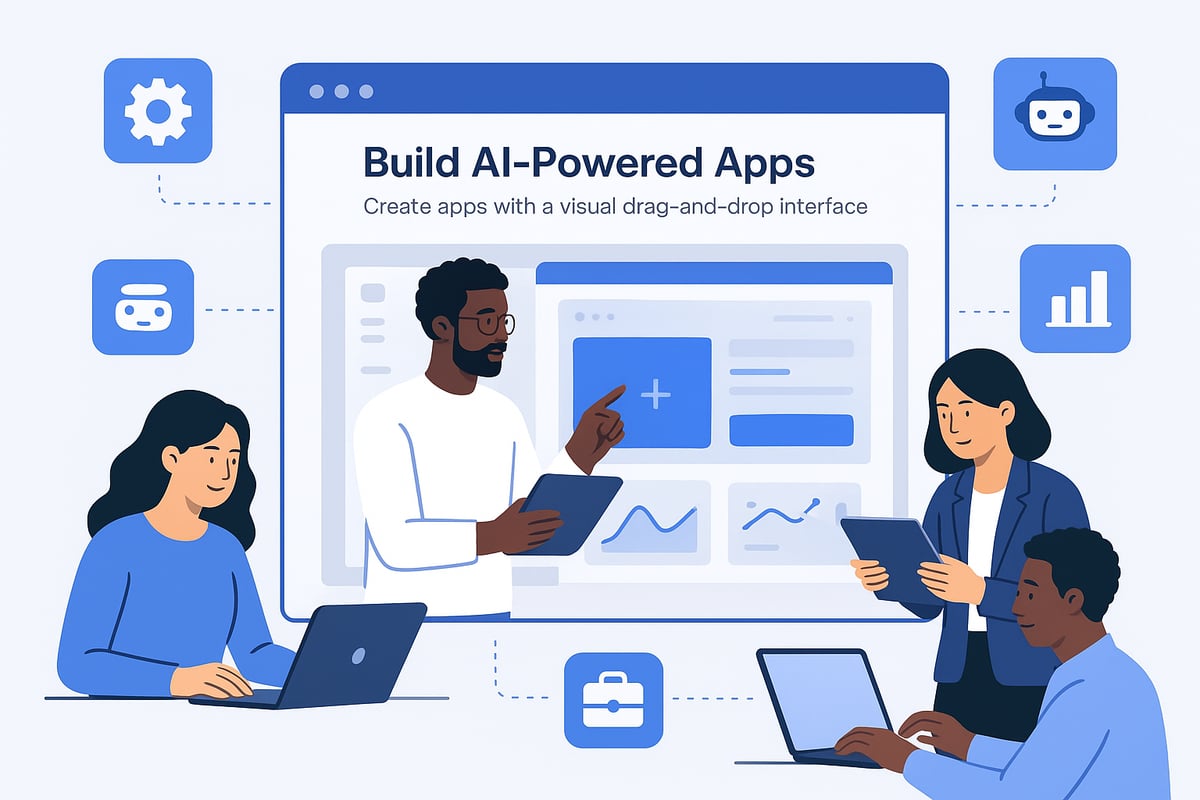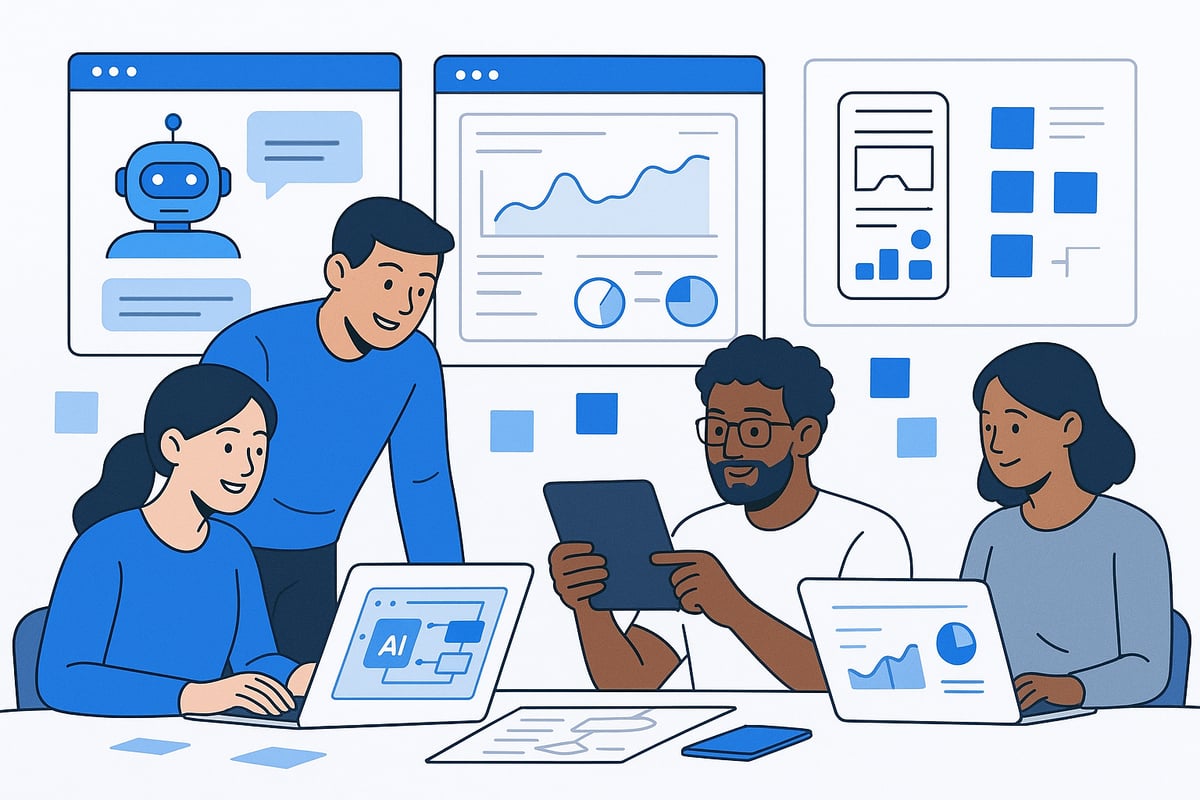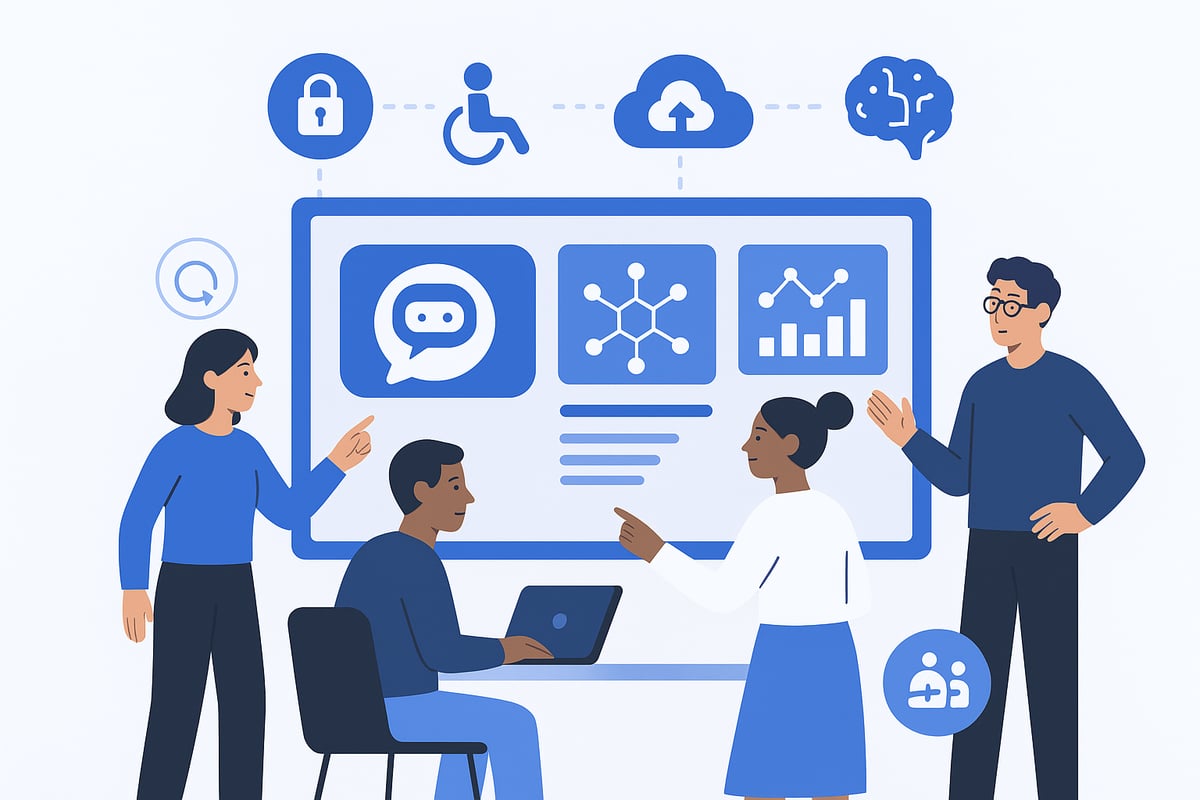Bubble AI is transforming how businesses innovate, automate, and scale. As we look ahead, 2025 is set to be a breakthrough year for organizations embracing smart technology.
In this guide, you will discover how bubble ai empowers users to create advanced solutions without coding. We will explore its core features, industry applications, and the steps to build with this powerful no-code platform.
Why is this important now? The explosive growth of AI-powered no-code platforms is lowering barriers for both startups and enterprises. You will gain actionable insights to harness bubble ai for your own digital transformation.
Ready to unlock smart solutions? Dive in and see how you can drive your business forward in 2025.
Understanding Bubble AI: A 2025 Overview
Bubble AI is rapidly changing how people build software, making advanced technology accessible without the need for complex coding skills. In this section, we break down what Bubble AI is, highlight its features, compare it to other platforms, and look at where it fits in the booming no-code market for 2025.

What is Bubble AI?
Bubble AI is a no-code platform that brings together easy app-building and advanced artificial intelligence. It lets users create complex applications visually, so you do not need to write traditional code to build something powerful. With Bubble AI, you can automate workflows, analyze data, and create smart user experiences, all within a single platform.
Compared to classic software development, Bubble AI is faster and much more approachable for non-developers. Unlike other no-code tools, it has deep AI integration, allowing users to add smart features quickly. Its rising popularity is clear, as more people in 2024 and 2025 look for Bubble No-Code Platform Overview resources to get started with no-code AI solutions.
Key Features and Capabilities
Bubble AI stands out with a visual drag-and-drop interface, making rapid app design accessible to everyone. Built-in AI components include chatbots, natural language processing, computer vision, and predictive analytics, all ready to use. You can connect your Bubble AI app to third-party AI services like OpenAI or Google Cloud AI for even more power.
Real-time data processing and workflow automation are at the core, letting businesses streamline operations. Whether you are a startup or an enterprise, Bubble AI scales easily as your needs grow. The platform is designed to support both small projects and large, mission-critical systems.
How Bubble AI Differs from Traditional No-Code Tools
What sets Bubble AI apart is its focus on AI-driven logic and automation. You can build custom workflows with AI triggers and actions, giving you more flexibility than older no-code platforms. Enhanced data security and compliance features make it suitable for enterprise use, too.
One standout advantage is the speed of development. With Bubble AI, prototyping and iteration cycles are much shorter. For example, a fintech startup used Bubble AI to launch an AI-powered dashboard in just a few weeks, a process that would have taken months with traditional approaches.
| Feature | Bubble AI | Traditional No-Code |
|---|---|---|
| AI Integration | Built-in, advanced | Limited |
| Workflow Automation | Highly customizable | Basic |
| Security & Compliance | Enterprise-ready | Varies |
| Prototyping Speed | Very fast | Moderate |
The 2025 AI-Driven No-Code Market Landscape
The no-code and low-code market is expected to grow beyond $65 billion by 2025, with AI integration as the main reason for this surge. Industry reports show that businesses see AI as the top driver for adopting platforms like Bubble AI.
Bubble AI stands out among competitors by offering more customization and smarter automation. Trends for 2025 include the democratization of AI, a stronger push for tailored solutions, and a focus on cost efficiency. As more companies seek to innovate quickly and affordably, Bubble AI is positioned as a leader in the smart no-code revolution.
Unlocking Smart Solutions with Bubble AI
Bubble AI is redefining how organizations approach automation, customer engagement, and data strategy. By combining a no-code platform with advanced AI, businesses are finding new ways to innovate and scale. Let’s explore how Bubble AI unlocks smart solutions across real-world scenarios.

Automating Business Processes
Bubble AI makes it easy to automate repetitive tasks that once took hours. Imagine a retailer using Bubble AI to track inventory levels and trigger automatic restocking when supplies run low. With drag-and-drop workflows, businesses can set up logic for tasks like data entry, invoice generation, and appointment reminders.
Benefits include:
- Less manual work for staff
- Fewer human errors
- Improved operational efficiency
Want to supercharge your automations? Explore the Top AI Plugins for Bubble to unlock even more powerful capabilities for your Bubble AI projects.
Enhancing Customer Experience with AI
Delivering standout customer experiences is simple with Bubble AI. Businesses can deploy AI chatbots to answer questions instantly, offering support around the clock. Predictive analytics help personalize recommendations, boosting engagement and sales.
For example, an e-commerce platform can use Bubble AI to suggest products based on browsing habits. This personalization not only increases conversion rates but also builds customer loyalty. With Bubble AI, companies can meet customers’ needs proactively.
Data-Driven Decision Making
Bubble AI brings advanced analytics and real-time dashboards to your fingertips. Companies can track KPIs, monitor trends, and make informed decisions using data visualized in clear reports. Machine learning models within Bubble AI help uncover patterns in sales, logistics, or customer behavior.
Picture a logistics company optimizing delivery routes using AI-powered insights. By leveraging Bubble AI, organizations transform raw data into actionable strategies, leading to smarter, faster decisions that drive growth.
Integrating AI Agents and Virtual Assistants
Building custom AI agents is seamless with Bubble AI. Internal HR teams can deploy onboarding bots to guide new hires, while customer-facing departments use AI-powered helpdesks to resolve issues quickly. Financial advisors and healthcare providers benefit from virtual assistants that offer instant, accurate responses.
For instance, a startup can cut support costs by creating an AI-driven helpdesk within Bubble AI. This solution scales easily as the business grows, ensuring consistent service without extra overhead.
Industry-Specific Applications
Bubble AI adapts to diverse industries with tailored solutions. In healthcare, AI-powered triage bots schedule appointments and direct patients efficiently. Fintech firms automate loan approvals and detect fraudulent transactions, reducing risk. Real estate agencies use Bubble AI for property matching and lead scoring, streamlining client acquisition.
Industry adoption is accelerating. AI use in healthcare is projected to grow by 40% year-over-year through 2025, highlighting the rising impact of Bubble AI across sectors. Companies leveraging Bubble AI are staying ahead of the curve and setting new standards in their fields.
Step-by-Step Guide: Building with Bubble AI in 2025
Building with bubble ai in 2025 is all about blending simplicity, power, and speed. Whether you are a startup founder or an enterprise innovator, this guide helps you turn ideas into robust AI-powered apps. Let us break down the process into actionable steps, making it easy to harness the full potential of bubble ai.

Step 1: Scoping and Planning Your Solution
Every bubble ai project starts with a clear vision. Begin by defining your business objectives and the problems you want to solve. Identify your target users and gather insights into their pain points.
Map out the key AI use cases. Are you looking to automate repetitive tasks, provide smart analytics, or create AI-powered chatbots? Write down your must-have features and nice-to-haves. For example, a startup might outline the need for an AI-driven CRM that automates lead scoring and follow-ups.
Create a simple requirements document. This helps guide your build and keeps your team aligned. If you want a deeper dive, check out this guide on building scalable MVPs with Bubble for practical planning tips.
Step 2: Designing the User Experience
The next step in building with bubble ai is crafting an intuitive user experience. Use Bubble’s visual editor to sketch wireframes and interactive prototypes. Start with core screens and user flows. Keep navigation simple and prioritize clarity.
Integrate AI features thoughtfully. For instance, place chatbots in prominent positions or add predictive suggestions where users need them most. Remember, great UX increases adoption and retention rates.
Run quick feedback sessions with stakeholders or beta users. Tweak layouts, add tooltips, and ensure accessibility for all. Bubble ai gives you the flexibility to iterate quickly, so do not hesitate to experiment.
Step 3: Integrating AI Components
With your design in place, it is time to power up your app with AI. Bubble ai makes it easy to add components like natural language processing, computer vision, or recommendation engines.
Connect to external AI APIs such as OpenAI, Google, or AWS for advanced functionality. For example, you might use a language model to enable multilingual support or image recognition to automate document uploads.
Bubble ai’s plugin marketplace offers pre-built modules for common AI tasks. Drag and drop the features you need, then use Bubble’s workflow editor to define how your app interacts with AI services.
Step 4: Workflow Automation and Logic
Automating business logic is where bubble ai shines. Set up workflows using triggers, actions, and conditions. For example, automate invoice generation when a sale closes, or score leads based on AI predictions.
Use Bubble’s visual workflow builder to map out each step. Test automations in a sandbox environment to catch errors early. Refine logic as you gather real-world data and feedback.
Automating repetitive tasks with bubble ai frees your team to focus on growth and innovation. Well-built workflows also reduce errors and improve operational efficiency.
Step 5: Data Management and Security
Data is at the heart of any AI-powered solution. With bubble ai, configure secure storage for sensitive information. Set user permissions to control access and protect privacy.
Stay compliant with regulations like GDPR or HIPAA. Use built-in features to anonymize data or log user actions for audits. AI can also help by flagging suspicious activity or detecting anomalies in real time.
Review your security settings regularly. As your app grows, update roles and permissions to match new requirements. Bubble ai’s security tools make it easier to safeguard your users and reputation.
Step 6: Testing, Launch, and Iteration
Before going live, put your bubble ai app through rigorous testing. Combine automated tests with manual walkthroughs to catch bugs and usability issues.
Gather feedback from early users and analyze behavior using built-in analytics. Use AI insights to spot trends or areas for improvement. Launch a minimum viable product (MVP) first, then iterate based on data.
As your user base expands, scale infrastructure and update AI models for accuracy. Bubble ai’s platform is designed for rapid iteration, so you can roll out new features and enhancements quickly.
Best Practices for Maximizing Bubble AI’s Potential
Unlocking the full potential of bubble ai requires a strategic approach. By following proven best practices, businesses can build robust, scalable, and user-friendly solutions that stand out in 2025’s competitive no-code landscape.

Optimizing Performance and Scalability
To ensure your bubble ai applications run smoothly as user demand grows, focus on performance from the start. Use efficient database structures, minimize unnecessary workflows, and leverage Bubble’s built-in performance monitoring tools.
- Group repeating elements to minimize data queries.
- Utilize Bubble’s server-side actions for heavy computations.
- Regularly test app speed under simulated high-traffic loads.
For enterprises, scaling bubble ai from a handful of users to thousands is achievable with careful resource planning and periodic optimization. Consider using a table to summarize core strategies:
| Strategy | Benefit |
|---|---|
| Database indexing | Faster data retrieval |
| Modular workflows | Easier maintenance |
| Load testing | Predictable performance |
By proactively addressing scalability, you future-proof your bubble ai projects for growth.
Ensuring Data Privacy and Compliance
Data protection is essential as bubble ai platforms process sensitive information. Start by implementing robust security protocols, such as two-factor authentication and encrypted data storage.
- Assign user roles and permissions thoughtfully.
- Monitor access logs for unusual activity.
- Regularly update privacy policies to reflect new regulations.
Staying compliant with laws like GDPR and HIPAA is critical for trust and legal safety. In 2025, updated regulations require more transparent AI usage disclosures and consent management. Always use bubble ai’s built-in privacy tools and consult legal experts when handling regulated data.
Protecting data not only secures your bubble ai app but also builds customer confidence.
Building for Accessibility and Inclusivity
Designing bubble ai solutions for everyone means embracing accessibility and inclusivity from the ground up. Follow WCAG 2.2 guidelines to ensure your app is usable by people with disabilities.
- Use sufficient color contrast and text size.
- Provide alt text for images and AI-generated content.
- Enable keyboard navigation throughout the interface.
AI features in bubble ai can power adaptive interfaces such as voice navigation for visually impaired users or real-time language translation. By prioritizing accessibility, you expand your app’s reach and deliver value to a diverse audience.
Inclusive design is not just a legal requirement, it is a competitive advantage for bubble ai creators.
Continuous Learning and AI Model Updates
AI evolves rapidly, so bubble ai projects should plan for ongoing learning and updates. Regularly review and update integrated AI models to maintain accuracy, relevance, and fairness.
- Subscribe to bubble ai’s update channels and forums.
- Evaluate new plugins and AI features as they become available.
- Monitor outputs for bias and unexpected results.
Stay informed about platform advancements by reading resources like Bubble's AI Vision AMA Recap, which details future integration plans. By continuously improving your bubble ai app, you ensure long-term success and adaptability.
Collaborating with No-Code and AI Experts
Partnering with experienced agencies or consultants can accelerate your bubble ai development and reduce costs. Experts bring best practices, troubleshoot complex integrations, and help you avoid common pitfalls.
- Seek agencies with proven bubble ai portfolios.
- Review client testimonials and case studies.
- Define clear project scopes and deliverables.
As highlighted in Why Hiring a Bubble Agency is Smart, collaboration can halve development time and boost solution quality. For ambitious projects, expert guidance ensures your bubble ai investment pays off.
The Future of Bubble AI: Trends and Innovations for 2025
The pace of innovation in bubble ai is accelerating as 2025 approaches. With new AI-driven features, expanding industry adoption, and a growing community of creators, the future of bubble ai is bright and full of opportunity. Let’s explore what lies ahead for this transformative no-code platform.
Evolving AI Capabilities on Bubble
Bubble ai’s capabilities are rapidly evolving, driven by advancements in generative AI, multimodal models, and deep analytics. In 2025, users can leverage generative design to prototype applications faster, while multimodal AI unlocks new possibilities in voice, image, and text processing. Businesses are already using these tools to streamline workflows and create innovative products.
According to Bubble's 2025 State of Visual Development, the platform now supports advanced AI integrations, making it easier than ever to embed intelligence directly into apps. As these features mature, bubble ai is expected to play a central role in the next wave of app development.
Industry Adoption and Use Cases
Industries like fintech, healthcare, logistics, and education are leading the adoption of bubble ai. Enterprises are automating mission-critical processes, reducing costs, and improving efficiency. For example, fintech startups are launching AI-powered dashboards, while healthcare providers use bubble ai for patient triage and scheduling.
Recent statistics show that AI-powered no-code platforms like bubble ai are projected to drive up to 60% of new app launches in 2025. This widespread adoption demonstrates the platform’s flexibility and effectiveness across a range of sectors, setting new standards for innovation.
Democratization of AI and No-Code Development
Bubble ai is at the forefront of democratizing AI and no-code development. By lowering technical barriers, it enables non-technical founders and small businesses to build sophisticated applications. The surge in bubble ai tutorials, plugins, and community forums empowers more people to become “citizen developers.”
This trend is fostering a culture of innovation and collaboration. As the bubble ai ecosystem grows, users benefit from shared knowledge, faster learning, and a supportive environment that accelerates digital transformation for everyone.
Challenges and Opportunities Ahead
Despite the promise of bubble ai, challenges remain. Addressing AI bias, ensuring data privacy, and navigating platform limitations are top priorities. Developers must also stay vigilant about ethical concerns and compliance requirements as AI becomes more integrated.
However, these challenges bring new opportunities. Innovations in AI-powered personalization, automation, and global scalability are on the horizon. By embracing best practices and staying informed, businesses can harness bubble ai to stay ahead in a competitive digital landscape.
You’ve seen how Bubble AI is changing the game for building smart solutions fast—from automating tasks to enhancing customer experiences and making data driven decisions. If you’re ready to take your idea from concept to reality without months of waiting or complex coding, you don’t have to do it alone. At Big House Technologies, we help founders and teams like you launch scalable MVPs in record time using no code and AI. Why not see how quickly you could get your product into users’ hands? Launch Your MVP in Weeks, Not Months




About Big House
Big House is committed to 1) developing robust internal tools for enterprises, and 2) crafting minimum viable products (MVPs) that help startups and entrepreneurs bring their visions to life.
If you'd like to explore how we can build technology for you, get in touch. We'd be excited to discuss what you have in mind.
Other Articles
We ran an experiment comparing Bubble and Webflow by building identical websites to test SEO and performance. Read on to explore the results and determine which platform offers better features for your business.
Discover essential software teaming best practices for 2025. Learn proven strategies, structures, and tools to build high-performing, agile software teams.
Learn how to connect SendGrid to your Bubble app with this step-by-step guide, fix sender verification issues, and unlock email automation for MVPs, AI tools, and enterprise apps.

